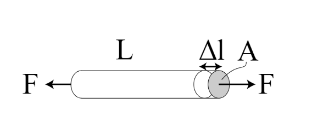
Longitudinal strain is calculated using the formula
E. Change in length/ Original length
F. Original length/ Change in length
G. Original length$ \times $ Change in length
H. Original length$ - $ Change in length
Answer
519.9k+ views
Hint: Longitudinal strain is caused due to longitudinal stress and is denoted by the Greek letter . When a deforming force or external force is applied on an object, its intermolecular or interatomic distances vary.
Complete Step by step answer: We know that all solids are elastic by nature. Atoms or molecules shall constitute them. Each atom or molecule is surrounded by neighbouring atoms or molecules which are bonded together by the intermolecular forces and shall stay in equilibrium. When a deforming force or an external force is applied on the object, a restoring force will be generated to gain back the equilibrium, thus regaining original size and shape.
When an object is subjected to a deforming force, the restoring force will be generated to oppose the deforming force and get back t0 its original shape and size.

Consider a cylinder as shown in the figure with length $L$ and cross-sectional area $A$ of the cylinder. When a force $F$ is applied such that it is perpendicular to the cross-sectional area, there will be a change in its length. The length will increase from $L$ to $L + \Delta L$ where $\Delta L$ is the change in length. Thus, the change in dimension to the original dimension is defined as strain. It gives the amount of stress an object is experiencing.
Thus the longitudinal strain can be defined as the ratio between the change in length $\Delta L$ and original length $L$.
$ \Rightarrow \varepsilon = \dfrac{{\Delta L}}{L}$ That is, Longitudinal strain=change in length/original length.
$\therefore $ Option A is correct.
Note: Students can commit mistakes by getting confused between the formulas of stress and strain. It can be remembered as stress expresses internal forces that every particle exert on each other whereas strain is the measure of the deformation of the material.
Complete Step by step answer: We know that all solids are elastic by nature. Atoms or molecules shall constitute them. Each atom or molecule is surrounded by neighbouring atoms or molecules which are bonded together by the intermolecular forces and shall stay in equilibrium. When a deforming force or an external force is applied on the object, a restoring force will be generated to gain back the equilibrium, thus regaining original size and shape.
When an object is subjected to a deforming force, the restoring force will be generated to oppose the deforming force and get back t0 its original shape and size.

Consider a cylinder as shown in the figure with length $L$ and cross-sectional area $A$ of the cylinder. When a force $F$ is applied such that it is perpendicular to the cross-sectional area, there will be a change in its length. The length will increase from $L$ to $L + \Delta L$ where $\Delta L$ is the change in length. Thus, the change in dimension to the original dimension is defined as strain. It gives the amount of stress an object is experiencing.
Thus the longitudinal strain can be defined as the ratio between the change in length $\Delta L$ and original length $L$.
$ \Rightarrow \varepsilon = \dfrac{{\Delta L}}{L}$ That is, Longitudinal strain=change in length/original length.
$\therefore $ Option A is correct.
Note: Students can commit mistakes by getting confused between the formulas of stress and strain. It can be remembered as stress expresses internal forces that every particle exert on each other whereas strain is the measure of the deformation of the material.
Recently Updated Pages
Physics and Measurement Mock Test 2025 – Practice Questions & Answers

NCERT Solutions For Class 5 English Marigold - The Little Bully

NCERT Solutions For Class 12 Maths Three Dimensional Geometry Exercise 11.1

NCERT Solutions For Class 11 English Woven Words (Poem) - Ajamil And The Tigers

NCERT Solutions For Class 6 Hindi Durva - Bhaaloo

NCERT Solutions For Class 12 Physics In Hindi - Wave Optics

Trending doubts
1 ton equals to A 100 kg B 1000 kg C 10 kg D 10000 class 11 physics CBSE

Difference Between Prokaryotic Cells and Eukaryotic Cells

One Metric ton is equal to kg A 10000 B 1000 C 100 class 11 physics CBSE

1 Quintal is equal to a 110 kg b 10 kg c 100kg d 1000 class 11 physics CBSE

Proton was discovered by A Thomson B Rutherford C Chadwick class 11 chemistry CBSE

Draw a diagram of nephron and explain its structur class 11 biology CBSE




